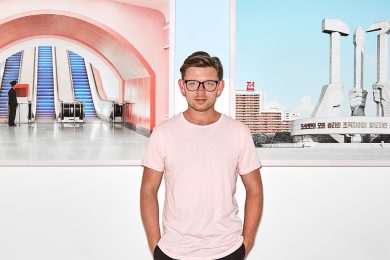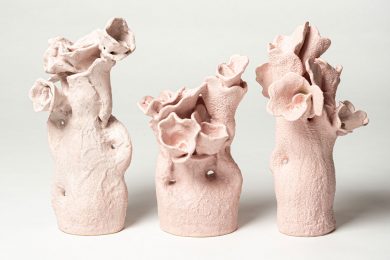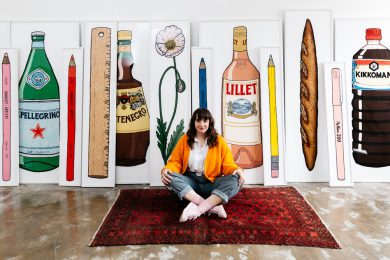Artist in Focus: Dave Kulesza
A lifelong fascination with the Democratic People’s Republic of Korea led our next artist in Focus - Melbourne-based photographer Dave Kulesza - to a three-day adventure exploring and capturing the essence of the Hermit Kingdom in 2019.
Captivated by the presence of colour and the links between the country’s architecture and complex political history, Dave headed to North Korea with a carefully-crafted list of locations - selected from the approved ‘tourist menu’ - and a western tour guide. The resulting series titled DPRK: North Korea In Colour offers a rare window into North Korea’s enigmatic capital, Pyongyang.
Colour, squeaky clean surfaces, brutalist structures and open, empty plazas fill these images beneath perfectly pastel skies. Everything has its place; there’s not a scrap of rubbish or a chair out of line. These stylised real-life scenes captured by Dave in romantic hues reference the large scale propaganda murals he encountered in various parts of the city.
This series sheds light on a country still shrouded in mystery today. And under our Artist in Focus banner, we’re delighted to speak to Dave in more detail about his time in the Hermit Kingdom of North Korea.
You’ve long been fascinated with the DPRK and the structures found there. How did this fascination turn into an opportunity to visit and photograph the capital Pyongyang?
My discovery of the country’s architecture came three years ago when a family member of mine began a unique new job opportunity as a western tour guide in North Korea. Over the years the idea of visiting and photographing the incredible structures in this mysterious country were something of a fantasy. The turning point which made the opportunity a reality was the day I received notice that my contact was concluding his time as a guide in November 2019. This fast tracked everything and I was on a plane heading to meet Matt in Dandong, China within a month of the news.
North Korea is shrouded in an air of mystery thanks to their strict visitation and immigration/emigration laws, and these images give us an insight into a rarely-experienced side of Pyongyang. Did this concept play on your mind while photographing these places?
The Hermit Kingdom - known for its mystery - is certainly opening itself up to the world year by year. This was really a trip like no other with limited control, so the only intention during my time there was to capture anything interesting that caught my eye and work the rest out later. Finding enough relevant places to visit over a three-day period presented its own challenges, however if you dig deep enough you can find it, at least enough to give you a good start. Although many places I aimed to visit were on the tourism menu, it was the unanticipated moments in between which proved to be the most impactful images of the series. I was grateful to have the opportunity to capture these unexpected moments and perhaps showcase a lesser seen side of the DPRK.
Did you have free creative license and access when shooting? Or were there significant restrictions? If so, how did these restrictions affect the final results?
My location list was carefully crafted around various locations in Pyongyang which fascinated me, researched via Instagram, Google, YouTube docos and some suggestions from my experienced guide. These locations had to be approved prior to my visit and once again early on in our trip. All my desired locations are on ‘the tourism list’ so they are accessible to tourists however unfortunately not all of them were approved to visit.
I generally had full creative control once we were there however I had no control over the day, time of day or duration spent at each location. This made it extremely difficult as I had no opportunity to return to these locations if something was missed.
You’ve spoken about the presence of colour in Pyongyang and that you felt very drawn to this. Tell us more about how colour informed this body of work.
The presence of colour seemed to play a large and significant role in the design of North Korea. This theme naturally translated into the imagery and I decided it was only fitting to base the series around it. Although colours weren’t manipulated in the interior images, the sky was in some of the exteriors. The main source of inspiration for this came from the large scale propaganda murals seen in various parts of the city. These murals depicted uplifting scenes of past leaders Kim Il-Sung and Kim Jong-il in various nostalgic moments throughout their time in leadership. The skies illustrated here always seemed surreal; like something from your imagination. In my series, pastel pink oak frames carry this theme through, complementing the pastel tones in the images and making the frame a part of the work.
How would you describe the architecture and interior design you saw and visited in North Korea?
Based on my own research - and from what I’ve gathered and seen - there seemed to be two types of design which may have been influenced by specific parts of the country’s history, and the leaders at the time. The old came from old forms, buildings erected from as early as its beginnings in the 50s during the Kim Il-Sung era and extending to the end of the Kim Jong-il era of 2011. These building styles seemed to take on the forms of brutalist structures, grand monuments and generic housing blocks, accenting the soviet influence on the country at that time. They still stand untouched to this day. There is no need for redeveloping in these socialist systems as each structure was built for a purpose. The only updates made are cosmetic and they take effective form through colour, in particular pastel colours internally and externally.
The new style of architecture is completely unique and a vast contrast to anything else in the city. You find colourful, retro-futuristic apartment buildings and restaurants, commonly seen along the Mirae Scientist Street and the atom shaped Sci-tech centre. These seem to reflect the style and influence of the current leader Kim Jong-un.
Post-production and editing are important parts of your work, and they play a huge role in your distinctive aesthetic. Do you think this will always naturally come through in your work?
Post production is equally as important to me in producing imagery as photography itself. Both aspects of the trade serve their own purpose and help define each photographer’s identity through their aesthetic. I believe it’s only natural to develop a style suited to your work and this style continues to refine itself over time.
Behind the scenes photography by Matt Kulesza.



